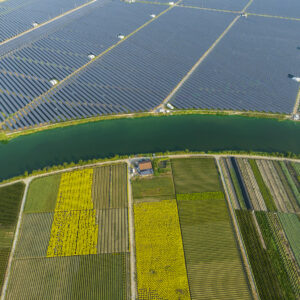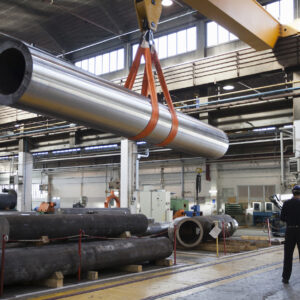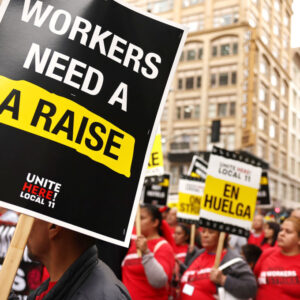Industrial Policy 2025: Bringing the State Back In (Again)
February 11, 2024
By Todd N. Tucker (Foreword), Kyunghoon Kim, Saule T. Omarova, Jonas Algers, Andrea Furnaro, César F. Rosado Marzán, Lenore Palladino
The following essay collection brings together the ideas and reflections of a diverse group of scholars from around the world to answer the question: What institutions and strategies are missing from US industrial policy that could help it be more successful?

(Photo by Andriy Onufriyenko/Getty Images)
Foreword
Introduction
This collection of essays is a first-of-its-kind interdisciplinary analysis by a diverse group of scholars from around the world that aims to answer the question: What institutions and strategies are missing from US industrial policy that could help it be more successful? The collection looks at the potential tools of economic statecraft that could complement the tax credits and grants that have formed the core of the Biden administration’s first-term industrial agenda.
The ideas in this collection have two things in common. First, the cases described in each essay involve a more active role for the state in the economy than neoliberal scholars or policymakers in the United States have embraced in recent decades. Second, they have been practiced somewhere in the world at some point in time (including right now).
In other words, they are not merely theoretical; they are real-world precedents that scholars, policymakers, and the broader public can study and learn from—assuaging potential concerns about an expanded role for the American state. The case studies do not revel in “statism” for its own sake. Rather, each of this collection’s contributors analyzes a toolkit or strategy that would address concrete problems that currently bedevil US industrial strategy.
This foreword starts by taking stock of the last three years of industrial policy developments, and the criticisms these have generated from certain observers about what has been seen as excessive levels of state intervention. A second section looks to how comparative politics research can provide further context as to whether and how higher levels of intervention could be justified. A third section introduces the reader to the essays that make up this compilation, and how they push both theory and practice forward.
The New Industrial Policy and Its Critics
After decades of policymakers attempting to minimize the actual or perceived role of the state in the economy, the state is undeniably back as a key actor. State-dominated countries like Russia and China make daily headlines. States are waging wars against one another and against non-state actors around the globe. Closer to home, Presidents Trump and Biden have used emergency powers from the FDR era to tackle everything from manufacturing vaccines to the baby formula shortage to deploying heat pumps. The US has also deployed tax credits, loans, and grants on a scale not seen in generations.
Indeed, statecraft is at the center of the current US policy agenda.
The Biden administration came into office pledging to tackle four interrelated crises: the COVID-19 pandemic, the shuttered economy, inequality (racial, income, and otherwise), and the climate crisis (Linskey et al. 2022). Upon becoming president, Biden himself expanded on these goals in a press conference early in his term, insisting that “we start to reward work, not just wealth. I want to change the paradigm.” He saw lifting up the middle class and unions as core to “restoring the soul of the nation” (Biden 2021). While “Build Back Better” was the original and evocative frame for how Biden planned to respond to these interwoven crises, the press, and in particular Biden’s critics, began using the term Bidenomics (Politi 2020). After the passage of four major bills through a razor-thin congressional margin,1 and one of the most successful midterm election performances by an incumbent party in US history, Biden himself embraced the term.
Bidenomics is both a theory of economic growth and a theory of economic power, and it is meant to replace Reaganomics (Blumenthal and Marans 2023). In lieu of the latter’s “trickle-down” emphasis on shrinking the public sector and reducing its burden on the rich (in the thinking that this would spur economic growth) (Niskanen 1993), the former “is rooted in the recognition that the best way to grow the economy is from the middle out and the bottom up” (White House 2023a). This vision in turn centers on three pillars:
- Making public investments in America;
- Empowering workers to grow the middle class; and
- Promoting competition and challenging corporate concentration (White House 2023a).
The first plank was operationalized through the Inflation Reduction Act (IRA), the Infrastructure Investment and Jobs Act (IIJA), and the CHIPS and Science Act—each a major piece of (green) industrial policy that could add up to trillions of dollars in new spending (Carey and Ukita Shepard 2022; Goldman Sachs 2023). Former National Economic Council Director Brian Deese has explained that these investments are motivated by the desire to not only correct discrete market failures but also to provide a public backbone to a self-reinforcing growth dynamic that balances resilience and price stability, speed and resilience, and international and domestic considerations (Deese 2022).
The second plank, worker empowerment, is advanced through the promotion of tight (or “hot”) labor markets through the spending of the American Rescue Plan Act (ARPA) (Khattar and Vela 2022), use of the presidency’s bully pulpit, changes in labor law interpretation by presidential appointees at independent agencies (Meyerson 2023), weakening monopsony power in labor markets (Kaplan 2023), and the corollary benefits of the public investments under the first plank (Harvey 2022).2
The third plank (competition) is operationalized primarily through a new (or old) approach to antitrust and monopoly policy that seeks to constrain not only business concentration that leads to increases in prices for consumers but also concentration per se (which is seen as ruinous to democracy and innovation). This agenda is executed largely though independent agencies and the courts, but also through select attacks on problematic pricing and “junk fee” practices (Popp Berman 2022; Ramamurti 2023).3
The economic data suggests that state intervention has been productive and effective. The contribution of manufacturing construction to GDP is at the highest levels on record (Raimondo 2023). Employment in construction has reached highs not seen since the advent of modern record-keeping in 1939 (Boushey 2023). Academic estimates suggest that US-made solar and wind energy are now cost competitive with imports for the first time in a generation (DePillis 2023). According to the Rhodium Group and MIT’s Clean Investment Monitor, total investment in the clean energy economy reached $176 billion in late 2023, up 40 percent post-IRA and CHIPS (Bermel et al. 2023).
Despite this record, US policymakers’ launch of their new approach was sometimes overly defensive about the extent of the state’s footprint in the economy. In 2021, former National Economic Council Director Brian Deese made a major speech calling for a “one-time capital investment in this country” of hundreds of billions of dollars, noting, “Now these may sound like large numbers, but, in fact, these are among the most prudent and modest investments that this country could make, a capital investment in ourselves” (Atlantic Council 2021, emphasis added). A July 2023 administration report stated that, “President Biden’s approach is to collaborate with the private sector, with a strategy that is government-enabled and private sector-led” (CEA 2023). In Biden’s major speech inaugurating his approach to economics, he almost apologetically offered, “I’m a capitalist. If you guys go out here and you can make a billion dollars, go get it. Just pay a little more in taxes” (Biden 2023).4
This defensiveness has been alongside a rising chorus of critiques of the new industrial strategy from the right and left. These have come in a few varieties: critiques of what, where, who, and how. These perspectives question the role of the state, the nation, the private sector, and the demos (respectively) in industrial policy. The what critique questions whether states anywhere are even able to conduct industrial policy (and whether they have been at any time in history), and posits that industrial policy is essentially impossible, given the state’s supposedly inferior knowledge base and its inability to operate in the public interest (Lincicome and Zhu 2021). The where critique allows that industrial policy may be useful, but that it should be agnostic as to the national location of production (or even affirmatively seek out lowest cost locations) (Posen 2023). The who critique comes from the opposite side of the ideological spectrum, and questions whether the private sector should have any role whatsoever in the green transition (Gabor 2023). Finally, the how critique accepts the desirability of investment to increase the supply of clean energy, but takes issue with what it sees as the tendency of the public sector to do too many things at once. Sometimes called the “everything bagel” critique (Klein 2023), it faults the Biden administration for being insufficiently attentive to the supposed trade-offs between its policy priorities (Yglesias 2023).
There are elements within each that deserve respectful contemplation. The state will confront informational problems that will make it harder to enact the best policies. Excessive nationalism can make international cooperation harder. Relying too much on private actors can put public goals at the mercy of short-termist corporations that may suffer from their own information asymmetries, as shown by Danish wind company Orsted’s late 2023 cancellation of its offshore wind projects due to failure to add inflation adjustments into its contracts (McGeehan 2023). And unquestioning adherence to current regulatory processes can lead to missing out on the chance to innovate new and smarter ways of governing.5 Yet the practical upshot remains the same: There is no shortcut to more state capacity, as the market on its own cannot resolve the climate crisis. Indeed, careful studies have concluded that, even with the highly imperfect system of US statecraft, government entities with more capacity can help shepherd better outcomes (Liscow, Nober, and Slattery 2023; Wang, Yuan, and Rogers 2023).
Bringing the State Back In
The debates around the new industrial strategy can sometimes feel like they are taking place in a vacuum. Is US industrial policy too condition-heavy? Are permitting processes too slow? Is the government doing too much second guessing of private actors, or not enough? Fortunately, there is a robust comparative politics scholarship on the theory of the state that can shine light on these debates. In particular, social science can help evaluate whether and how the new directions for US statecraft are surprising and/or likely to be successful.
A particularly useful contribution to this inquiry is Bringing the State Back In, a landmark 1985 volume edited by sociologists Peter B. Evans, Dietrich Rueschemeyer, and Theda Skocpol. This book explored why so much research at the time appeared to minimize the actual or potential role of the state in economic life (Evans, Rueschemeyer, and Skocpol 1985). From liberal pluralists to neo-Marxists, many scholars treated the state as a relatively neutral arena of social conflict, with little appetite or capacity for independently shaping income growth or distribution. Rather, non-state social actors like business and labor groups had policy preferences determined exogenously by their “objective” economic interests or the ideas that attracted them, and they would then duke it out in political parties and government institutions. Whichever group was stronger would see their economic program prevail and carry the day. While state actors may appeal to notions of the national or public interest, in this view, such rhetoric is merely providing empty cover for delivering for the group or class that dominates the state as much as the rest of society.
The Bringing authors questioned these premises, finding many instances in which states were both willing and able to not only independently shape economic outcomes but also shape the very preferences and strategies of actors in the rest of society. The very growth of European states from the 16th century relied on a complex interplay between states’ capacity for war-making, extraction (revenue), and protection services (spending) (Tilly 1985).6 In the 19th century, the British state centralized the provision of key social services that in the US remained decentralized, racialized, and used for patronage purposes, thereby creating a stronger and more uniform sense of working-class identity in the United Kingdom than in the US (Katznelson 1985). And in the 20th century, the Taiwanese state was able to develop the island from a poor, agriculture-dominated economy to a manufacturing-dominated one through a sequence of interventions ranging from trade protection to monopolizing credit to relatively lighter-touch licensing regimes (Amsden 1985).
One case study is particularly instructive for this collection. What explains why some countries develop industrial policy and others do not? This chapter of Bringing looks at the differential responses of countries to the similar shock of the Great Depression. The UK, thanks in part to the aforementioned working-class mobilization, developed a national system of unemployment benefits in the early 20th century. Sweden did not, and in turn around the same time helped alleviate job market pains through paying the unemployed to labor on public works projects. When the Great Depression hit, social democratic interests in each country leaned into the policy mix that each state had already developed. In the UK, this meant opening up the spigot of benefits payments, while in Sweden, the social demands centered around making public works pay closer to union wages. The former was dependent on the revival of economic growth (to in turn increase tax collection), while the latter helped endogenously generate growth through making infrastructure that helped productivity. Success begat success (both economically and politically), enabling Swedish Social Democrats to win a string of elections and institute more of their economic program (discussed in this collection’s essay by César Rosado Marzán) than UK Labour was able to (Weir and Skocpol 1985).7
All of this is not to say that states are always (or even often) benevolent, efficiency-promoting, or effective. Rather, in cases in which states are able to establish some degree of autonomy from the classes that otherwise dominate the economy; develop a suite of administrative, legal, bureaucratic, and coercive powers; and then use those powers to reinforce the state’s own authority, legitimacy, and political longevity, they may be able to effectuate economic outcomes that reductive analyses would fail to predict.
While not a central reference point of the Bringing volume, present-day readers interested in questions of political economy might ask: How does all of this relate to neoliberalism and the search for alternatives to it? The answer: Quite a lot. The notions that bureaucrats lack sufficient information to engage in thoughtful planning, that government is invariably captured by the companies it seeks to regulate, or that government lacks the dynamism of private markets—each of these propositions found adherents among the political actors of the 1970s that modern historians credit (or fault) with making neoliberalism a reality (Slobodian 2018; Sabin 2021; Gerstle 2022). Furthermore, these notions are alive and well across the political spectrum today, hampering our ability to truly move beyond neoliberal policymaking tools.
Indeed, almost 40 years after the initial publication, the Bringing project seems more relevant than ever. This scholarship would inspire numerous offshoots, such as American Political Development, historical institutionalism, and policy feedback theory (Hacker et al. 2022; Fioretos 2017). In the subfields of climate politics and industrial policy, the state is seen as the indispensable actor in accompanying economic transitions (Meckling and Nahm 2022; Juhász, Lane, and Rodrik 2023; Armitage, Bakhtian, and Jaffe 2023).
Toward a Synthesis: Learning from What Works
The authors in this Industrial Policy 2025 collection provide rich comparative politics studies that have the potential to help answer questions and critiques sparked during Biden’s first term by “bringing the state back in.”
Kyunghoon Kim’s essay begins the collection with a thousand-foot view, exploring the question: Just how much state involvement is there out there? Much more than one might think, it turns out, and in unexpected places. By one indicator, France has more state involvement in the economy than Russia, and is not far behind centrally planned economies like China and Vietnam. Other major European economies like Switzerland and Germany have greater state involvement in the economy than countries with more recent avowedly “developmentalist” histories like South Africa, Argentina, and Chile. Some of the most recognizable multinational companies (such as Volkswagen) have state ownership, and indeed 20 percent of the planet’s largest companies (including numerous major players in finance) are state enterprises. Indonesia, a resource-rich emerging economy, has a wide range of state tools to manage resource rents. In short, as US policymakers and companies look at the competitive global landscape, they will encounter a “market” shaped indelibly by states at every level.
Saule Omarova’s essay establishes a rich taxonomy of state financial institutions. The first type, sovereign wealth funds, have long been associated with China and Middle Eastern countries. In fact, one of the largest such funds has been operational in Norway since 1969, is the single largest owner of stocks in the world, and is self-financed (and thus able to make social mission–oriented investments without the need to satisfy private bondholders). National development banking comprises a second type. One of the leading examples dates to 1948 in Germany, where the KfW provides loans and other supports for pandemic response, green transitions, and more. Singapore’s state holding company is exemplary of a third model, an institution that can exercise even more direct industrial policy state control over invested companies than the other types. Omarova then uncovers a US precedent that is not widely appreciated—the Reconstruction Finance Corporation, which financed the New Deal and World War II mobilization under the Franklin D. Roosevelt administration. She ends by discussing how her proposal for a National Investment Authority could flexibly combine the best of these models in the years ahead.
Jonas Algers’s essay looks at how a variety of state institutions are remaking and decarbonizing the steel industry in Sweden. The world’s leading “green steel” project is HYBRIT, a joint venture between utility, steel, and mining companies that are wholly or partly owned by governments, including public institutions in Sweden, Finland, and Canada. This project, as well as privately owned competitor H2 Green Steel, is receiving a wide range of public supports from both Swedish and EU public institutions. These projects stand out as particularly high value from a climate perspective, since primary steel production is one the most emissions-intensive industries and demand for low-carbon steel is on the rise from auto companies and others. The engineering of two competitor projects stands out as a model for how anti-monopoly and industrial policies can go hand in hand.
Instead of exploring how to wind up a new industry like green steel, Andrea Furnaro’s essay looks at using industrial policy to wind down an old one, coal, in Germany. Here, a dense network of EU and German programs accounting for billions of dollars in spending aim to simultaneously phase out carbon-intensive production and leave formerly coal-producing regions in a better place than when the program started. Furnaro outlines key factors that have made the German programs successful, including focusing on the ability of local, regional, and European institutions to become better economic planners. She also makes a contribution to theory, helping the reader better conceptualize the relationship between “place-based policy” and “just transition policy,” which she considers as subsets of industrial strategies.
How workers fare in industrial transitions is the theme of César Rosado Marzán’s essay, which discusses two historical cases. First, he looks at Sweden’s “Rehn-Meidner” model, the 1950s through 1970s socioeconomic arrangement whereby policymakers balanced industrial competitiveness, macroeconomic stability and wage gains for workers at the bottom of the pay scale. Then, he turns to Puerto Rico—the US territory that successfully developed a textile and apparel industry while adopting a sectoral bargaining strategy that gave mainland unions a toehold on the island. He closes by proposing “Fair Transition Boards” for the US clean energy transition, which could help turn what are currently low-wage jobs in emerging industries like solar module installation into higher-wage, good jobs.
Last but not least, Lenore Palladino’s essay brings us closer to the present through her case study of the bailout of Detroit automakers in the global financial crisis of 2008-2010. While much of our historical memory focuses on the ramifications of that crisis for the banking system, the US under President Obama and Vice President Biden partly nationalized manufacturing firms in ways that are not out of step with the previous case studies in this collection. Yet unlike some more forceful episodes of economic statecraft, the US refused to attach meaningful labor or other conditionalities in this bailout. Palladino concludes with recommendations of how the current EV transition could be made more economically and democratically sustainable.
Conclusion
None of these case studies are perfectly transposable to the United States context in 2024 and 2025. Indeed, a common theme of many of the essays is the crucial role played by supportive timing. As Omarova shows, the US lost its Reconstruction Finance Corporation at just the time the model transposed to Germany. When energy shock and transitions hit the German economy (and as historian Stephen Gross [2023] has shown, this has happened many times), the existence of these institutions (explored by Furnaro) enabled a nimbler response. Indonesia’s big push toward new state institutions (explored by Kim) came after the global financial crisis, as did Puerto Rico’s development of labor institutions in response to developments in the broader US mainland economy (described by Marzán).
The US has to take its own particularities into account, such as the outsized role played by a state-enabled yet non-state-checked billionaire class (Farrow 2023) and the history of racial exclusion leading to uneven trust of the state by distinct demographic groups (Tucker 2019). These characteristics can make the United States look more like a “failed state” than some of its close peers.
On the other hand, as a “late developer” in some modes of economic statecraft, the US can learn from what has come before. Indeed, part of the US turn toward industrial policy can be explained by observing the challenges to carbon pricing-centric approaches in other countries like Australia, Canada, and in Europe (Green 2021). And the US benefits from a higher degree of early fiscal federalization—which was created in a pre-neoliberal era—as compared with European institutions that built federal markets but uneven federal states (Bergsen et al. 2022; McNamara 2023; Stiglitz 2019).
Our hope is that this collection offers policymakers and other observers of American life some useful inputs as we contemplate where to go next after the successes and implementation challenges of the Inflation Reduction Act and other new policies.
_____
The author would like to thank Suzanne Kahn, Sonya Gurwitt, and Sunny Malhotra for comments and assistance on this project, as well as all the contributing authors.
Footnotes
Read the footnotes
1This included the rechristening by Senator Joe Manchin (D-WV) of the House-passed Build Back Better Act into the Inflation Reduction Act.
2Labor power can also help improve the quality of public subsidies to private firms, by having “whistleblowers” that can make sure that the funds are used well (Tucker et al. 2023).
3It is also integrated into the public investment plank through limits on stock buybacks and corporate extraction (Palladino and Estevez 2022).
4In the speech, Biden conflated “trickle-down economics” and “MAGA-nomics” in ways that flatten important political economy differences. Reagan and Bush I, for instance, paved the way for multilateral neoliberal institutions like the World Trade Organization (WTO), which Trump sought to weaken through unilateral state-led actions.
5See Bagley 2019 and Pahlka 2023 for discussion.
6In contrast, states that never had to invest in their own capacities and relied on external military and other protection often failed to develop such a balance that roughly corresponds to constitutional checks and balances.
7The United States under Franklin D. Roosevelt traversed a third way, responding in the early New Deal with industrial and infrastructure policy meant to help labor. America ultimately failed to institutionalize a robust version of that agenda due to state structures like a relatively powerful Supreme Court and Congress, leaving instead what the authors call “commercial Keynesianism”—a type of lower common denominator countercyclical policy that some share of the Republican Party and business interests could abide.
References
Read the References
Amsden, Alice H. 1985. “The State and Taiwan’s Economic Development.” In Bringing the State Back In, edited by Peter B. Evans, Dietrich Rueschemeyer, and Theda Skocpol, 78–106. Cambridge, UK: Cambridge University Press.
Armitage, Sarah C., Noël Bakhtian, and Adam B. Jaffe. 2023. “Innovation Market Failures and the Design of New Climate Policy Instruments.” Working Paper 31622. National Bureau of Economic Research Working Paper Series. https://doi.org/10.3386/w31622.
Atlantic Council. 2021. “Brian Deese on Biden’s Vision for ‘a Twenty-First-Century American Industrial Strategy.’” Atlantic Council, June 23, 2021. https://www.atlanticcouncil.org/commentary/transcript/brian-deese-on-bidens-vision-for-a-twenty-first-century-american-industrial-strategy/.
Bagley, Nicholas. 2019. “The Procedure Fetish.” Michigan Law Review 118, no. 3 (December): 345–402. https://doi.org/10.36644/mlr.118.3.procedure.
Bergsen, Pepijn, Leah Downey, Max Krahe, Hans Kundnani, Manuela Moschella, and Quinn Slobodian. 2022. “The Economic Basis of Democracy in Europe.” Chatham House, September 8, 2022. https://www.chathamhouse.org/2022/09/economic-basis-democracy-europe.
Bermel, Lily, Brian Deese, Michael Delgado, Leandra English, Yeric Garcia, Lisa Hansmann, Trevor Houser, Nakya Stewart, and Harold Tavarez. 2023. “Clean Investment Monitor: Q3 2023 Update.” Rhodium Group/MIT-CEEPR Clean Investment Monitor. https://www.cleaninvestmentmonitor.org/reports/q3-2023-update.
Biden, Joe. 2021. “Remarks by President Biden in Press Conference.” Speech, March 25, 2021, The White House. https://www.whitehouse.gov/briefing-room/speeches-remarks/2021/03/25/remarks-by-president-biden-in-press-conference/.
Biden, Joe. 2023. “Remarks by President Biden on Bidenomics | Largo, MD.” Speech, Prince George’s Community College, Largo, MD, September 14, 2023, The White House. https://www.whitehouse.gov/briefing-room/speeches-remarks/2023/09/14/remarks-by-president-biden-on-bidenomics-largo-md/.
Blumenthal, Paul, and Daniel Marans. 2023. “How ‘Bidenomics’ Came to Be, and How It Could Survive.” Huffington Post, July 24, 2023. https://www.huffpost.com/entry/bidenomics-2024_n_64bd314de4b093f07cb50f8e.
Boushey, Heather. 2023. “Job Gains in Construction After Two Years of the Bipartisan Infrastructure Law.” The White House (blog). November 15, 2023. https://www.whitehouse.gov/briefing-room/blog/2023/11/15/job-gains-in-construction-after-two-years-of-the-bipartisan-infrastructure-law/.
Carey, Lachlan, and Jun Ukita Shepard. 2022. “Congress’s Climate Triple Whammy: Innovation, Investment, and Industrial Policy.” Rocky Mountain Institute (blog). August 22, 2022. https://rmi.org/climate-innovation-investment-and-industrial-policy/.
Council of Economic Advisers (CEA). 2023. Economics of Investing in America. Washington, DC: Council of Economic Advisers. https://www.whitehouse.gov/wp-content/uploads/2023/07/Economics-of-Investing-in-America.pdf.
Chotiner, Isaac. 2023. “Why Obama’s ‘Car Czar’ Thinks Biden Should Stay Out of the U.A.W. Strike.” New Yorker, October 3, 2023. https://www.newyorker.com/news/q-and-a/why-obamas-car-czar-thinks-biden-should-stay-out-of-the-uaw-strike.
Dayen, David. 2023. “How State Capacity Can Help America Build.” The American Prospect, August 17, 2023. https://prospect.org/api/content/d1ee552e-3c7b-11ee-bd90-12163087a831/.
Deese, Brian. 2022. “Remarks on a Modern American Industrial Strategy By NEC Director Brian Deese.” Speech, Economic Club of New York, April 20, 2022. The White House. https://www.whitehouse.gov/briefing-room/speeches-remarks/2022/04/20/remarks-on-a-modern-american-industrial-strategy-by-nec-director-brian-deese/.
DePillis, Lydia. 2023. “Energy Tax Credits, Meant to Help U.S. Suppliers, May Be Hard to Get.” New York Times, June 9, 2023, sec. Business. https://www.nytimes.com/2023/06/09/business/economy/energy-tax-credits.html.
Evans, Peter B., Dietrich Rueschemeyer, and Theda Skocpol, eds. 1985. Bringing The State Back In. Cambridge, UK: Cambridge University Press.
Farrow, Ronan. 2023. “Elon Musk’s Shadow Rule.” New Yorker, August 21, 2023. https://www.newyorker.com/magazine/2023/08/28/elon-musks-shadow-rule.
Fioretos, Orfeo, ed. 2017. International Politics and Institutions in Time. New York, NY: Oxford University Press.
Gabor, Daniela. 2023. “The (European) Derisking State.” SocArXiv. https://osf.io/preprints/socarxiv/hpbj2.
Gerstle, Gary. 2022. The Rise and Fall of the Neoliberal Order: America and the World in the Free Market Era. Oxford University Press.
Goldman Sachs. 2023. “The US Is Poised for an Energy Revolution.” Goldman Sachs, April 17, 2023. https://www.goldmansachs.com/intelligence/pages/the-us-is-poised-for-an-energy-revolution.html.
Green, Jessica F. 2021. “Does Carbon Pricing Reduce Emissions? A Review of Ex-Post Analyses.” Environmental Research Letters 16, no. 4 (March): 043004. https://iopscience.iop.org/article/10.1088/1748-9326/abdae9.
Gross, Stephen G. 2023. Energy and Power: Germany in the Age of Oil, Atoms, and Climate Change. Oxford University Press.
Hacker, Jacob S., Alexander Hertel-Fernandez, Paul Pierson, and Kathleen Thelen. 2022. “The American Political Economy: Markets, Power, and the Meta Politics of US Economic Governance.” Annual Review of Political Science 25 no. 1: 197–217. https://doi.org/10.1146/annurev-polisci-051120-013916.
Harvey, Abby. 2022. A User Guide to the Inflation Reduction Act: How New Investments Will Deliver Good Jobs, Climate Action, and Health Benefits. Washington, DC: Blue Green Alliance. https://www.bluegreenalliance.org/wp-content/uploads/2023/02/BGA-IRA-User-Guide-Print-FINAL-Web.pdf.
Juhász, Réka, Nathan Lane, and Dani Rodrik. 2023. “The New Economics of Industrial Policy.” Working Paper 31538. Cambridge, MA: NBER. https://www.nber.org/papers/w31538.
Kaplan, Juliana. 2023. “The FTC Wants to Ban Companies from Telling Their Employees They Can’t Work for Competitors — and Says It’ll Help Workers Make $300 Billion More a Year.” Business Insider, January 5, 2023. https://www.businessinsider.com/ftc-wants-ban-noncompete-agreements-workers-make-300-billion-more-2023-1.
Katznelson, Ira. 1985. “Working-Class Formation and the State: Nineteenth Century England in American Perspective.” In Bringing the State Back In, edited by Peter B. Evans, Dietrich Rueschemeyer, and Theda Skocpol, 257–84. Cambridge, UK: Cambridge University Press.
Khattar, Rose, and Jessica Vela. 2022. “Despite Global Inflation, the U.S. Economic Recovery Is Among the Strongest of G-7 Nations.” Center for American Progress, December 9, 2022. https://www.americanprogress.org/article/despite-global-inflation-the-u-s-economic-recovery-is-among-the-strongest-of-g-7-nations/.
Klein, Ezra. 2023. “The Problem With Everything-Bagel Liberalism.” New York Times, April 2, 2023, sec. Opinion. https://www.nytimes.com/2023/04/02/opinion/democrats-liberalism.html.
Lincicome, Scott, and Huan Zhu. 2021. “Questioning Industrial Policy: Why Government Manufacturing Plans Are Ineffective and Unnecessary.” Working Paper 63. Washington, DC: Cato Institute. https://www.cato.org/working-paper/questioning-industrial-policy-why-government-manufacturing-plans-are-ineffective.
Linskey, Annie, Cleve R. Wootson, Jeff Stein, and Brady Dennis. 2022. “After One Year in Office, What Has Biden Done about the Four Crises He Pledged to Address?” Washington Post, January 20, 2022. https://www.washingtonpost.com/politics/interactive/2022/biden-covid-race-economy-climate/.
Liscow, Zachary, Will Nober, and Cailin Slattery. 2023. “Procurement and Infrastructure Costs.” Working Paper 31705. Working Paper Series. Cambridge, MA: National Bureau of Economic Research. https://doi.org/10.3386/w31705.
McGeehan, Patrick. 2023. “Wind Power, Key to Democrats’ Climate-Change Goals, Faces a Crisis.” New York Times, November 2, 2023, sec. New York. https://www.nytimes.com/2023/11/02/nyregion/wind-power-climate-change-democrats.html.
McNamara, Kathleen R. 2023. “Transforming Europe? The EU’s Industrial Policy and Geopolitical Turn.” Journal of European Public Policy, July. https://www.tandfonline.com/doi/abs/10.1080/13501763.2023.2230247.
Meckling, Jonas, and Jonas Nahm. 2022. “Strategic State Capacity: How States Counter Opposition to Climate Policy.” Comparative Political Studies 55, no. 3 (July): 493–523. https://doi.org/10.1177/00104140211024308.
Meyerson, Harold. 2023. “Biden’s NLRB Brings Workers’ Rights Back From the Dead.” The American Prospect, August 28, 2023. https://prospect.org/api/content/54e6445e-43a3-11ee-8651-12163087a831/.
Niskanen, William A. 1993. “Reaganomics.” In The Concise Encyclopedia of Economics, first edition. https://www.econlib.org/library/Enc1/Reaganomics.html.
Pahlka, Jennifer. 2023. Recoding America: Why Government Is Failing in the Digital Age and How We Can Do Better. Henry Holt and Company.
Palladino, Lenore, and Isabel Estevez. 2022. “The Need for Corporate Guardrails in US Industrial Policy.” Roosevelt Institute, August 18, 2022. https://rooseveltinstitute.org/publications/the-need-for-corporate-guardrails-in-us-industrial-policy/.
Politi, James. 2020. “Bidenomics: Sharp Shift to Left Touts Workers over Wealth.” Financial Times, September 28, 2020, sec. US presidential election 2020. https://www.ft.com/content/5bd190f5-9c0f-49bf-8a11-0dc9c18c991e.
Popp Berman, Elizabeth. 2022. “Reimagining Antitrust Law Will Boost Consumers, Workers and Innovation.” Washington Post, April 7, 2022. https://www.washingtonpost.com/outlook/2022/04/07/reimagining-antitrust-law-will-boost-consumers-workers-innovation/.
Posen, Adam. 2023. “America’s Zero-Sum Economics Doesn’t Add Up.” Foreign Policy, March 24, 2023. https://foreignpolicy.com/2023/03/24/economy-trade-united-states-china-industry-manufacturing-supply-chains-biden/.
Raimondo, Gina. 2023. “By the Numbers: Third Quarter Economic Growth Exceeds Expectations.” US Department of Commerce (blog). October 26, 2023. https://www.commerce.gov/news/blog/2023/10/numbers-third-quarter-economic-growth-exceeds-expectations.
Ramamurti, Bharat (@BharatRamamurti). 2023. “This is the rub. Using government policy to actually reduce prices, rather than just slow inflation –and without provoking a recession — is quite challenging. It’s useful to consider a couple examples where the Biden Administration has actually accomplished it. 1/” Twitter, November 7, 2023, 11:25am. https://twitter.com/BharatRamamurti/status/1721926775603855857.
Sabin, Paul. 2021. Public Citizens: The Attack on Big Government and the Remaking of American Liberalism. New York, NY: W. W. Norton & Company.
Slobodian, Quinn. 2018. Globalists: The End of Empire and the Birth of Neoliberalism. Cambridge, MA: Harvard University Press.
Stiglitz, Joseph E. 2019. Rewriting the Rules of the European Economy. Brussels: Foundation for European Progressive Studies. https://www.feps-europe.eu/attachments/publications/book_stiglitz-web-pp.pdf.
Tilly, Charles. 1985. “Warmaking and Statemaking as Organized Crime.” In Bringing the State Back In, edited by Peter B. Evans, Dietrich Rueschemeyer, and Theda Skocpol, 169–90. Cambridge, UK: Cambridge University Press.
Tucker, Todd N. 2019. “Industrial Policy and Planning: What It Is and How to Do It Better.” Roosevelt Institute, . https://rooseveltinstitute.org/industrial-policy-and-planning/.
Tucker, Todd N., Sameera Fazili, Jane Flegal, Jennifer M. Harris, Janelle Jones, K. Sabeel Rahman, and Tim Wu. 2023. Industrial Policy Synergies: Reflections from Biden Administration Alumni. New York: Roosevelt Institute. https://rooseveltinstitute.org/publications/industrial-policy-synergies-reflections-from-biden-administration-alumni/.
Wang, Jia, Weici Yuan, and Cynthia L. Rogers. 2023. “Economic Development Program Spending in the US: Is There Club Convergence?” Applied Economics 55, no (October)43: 5097–5114. https://doi.org/10.1080/00036846.2022.2136359.
Weir, Margaret, and Theda Skocpol. 1985. “State Structures and the Possibilities for ’Keynesian’responses to the Great Depression in Sweden, Britain, and the United States.” In Bringing the State Back In, edited by Peter B. Evans, Dietrich Rueschemeyer, and Theda Skocpol, 107–67. Cambridge, UK: Cambridge University Press.
The White House. 2023. “Bidenomics Is Working: The President’s Plan Grows the Economy from the Middle Out and Bottom Up—Not the Top Down.” Press release, June 28, 2023. https://www.whitehouse.gov/briefing-room/statements-releases/2023/06/28/bidenomics-is-working-the-presidents-plan-grows-the-economy-from-the-middle-out-and-bottom-up-not-the-top-down/.
Yglesias, Matthew. 2023. “Every Policy Objective, All the Time, All at Once.” Slow Boring (blog). April 26, 2023. https://www.slowboring.com/p/every-policy-objective-all-the-time.
The Role of State Ownership: Overview of State-Owned Entities in the Global Economy
by Kyunghoon Kim

Finance as a Tool of Industrial Policy: A Taxonomy of Institutional Options
by Saule T. Omarova
Leading With Industrial Policy: Lessons for Decarbonization from Swedish Green Steel
by Jonas Algers

Just Energy Transition in the Time of Place-Based Industrial Policy: Patch or Pathway to the Green Industrial Transformation?
by Andrea Furnaro
Fair Transition Funds, Employer Neutrality, and Card Checks: How Industrial Policy Could Relaunch Labor Unions in the United States
by César F. Rosado Marzán
Electric Vehicles: How Corporate Guardrails Can Improve Industrial Policy Outcomes
by Lenore Palladino
Why This Matters
There is a critical window to make the case for a more robust industrial policy—and we want to meet the moment. This essay collection offers policymakers and other observers of American life some useful inputs as we contemplate where to go next after the successes and implementation challenges of policies such as the Inflation Reduction Act, the Infrastructure and Jobs Act, the American Rescue Plan Act, and many more.
NEW 📰 With the state’s capacity back at the center of the US policy agenda, it’s time for a new generation of industrial policy.
Our new report brings together authors & case studies from across the world, arguing for a more robust IP toolkit 🧵 #IP2025https://t.co/5hQpR7vjXV pic.twitter.com/qg9jbDdwIc
— Roosevelt Institute (@rooseveltinst) February 13, 2024










